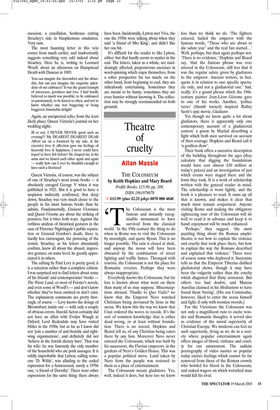Theatre of cruelty
Allan Massie
THE COLOSSEUM by Keith Hopkins and Mary Beard Profile Books, £15.99, pp. 209, ISBN 1861974078 ✆ £13.99 (plus £2.25 p&p) 0870 800 4848 ‘The Colosseum is the most famous and instantly recognisable monument to have survived from the classical world.’ In the 19th century the thing to do when in Rome was to visit the Colosseum by moonlight, and quote Byron. This is no longer possible. The ruin is closed at dusk, and anyway the moon will have been obscured by the combination of street lighting and traffic fumes. Thronged with tourists, the Colosseum is not the place for Romantic reveries. Perhaps they were always inappropriate.
Everybody knows the Colosseum, but far less is known about what went on there than many of us may suppose. Misconceptions abound. Thanks to Quo Vadis? we know that the Emperor Nero watched Christians being devoured by lions in the arena. We know this the way we know that Cnut ordered the waves to recede. It’s the sort of common knowledge that is either dead wrong, or at least without foundation. There is no record, Hopkins and Beard tell us, of any Christian being eaten there by any lion. Moreover Nero never entered the Colosseum, which was built by his successors, the Flavian emperors, in the gardens of Nero’s Golden House. This was a popular political move. Land taken by Nero from the people was restored to them as a place of entertainment.
The Colosseum means gladiators. Yes, well, indeed it does, but here too we know less than we think we do. ‘The fighters entered, hailed the emperor with the famous words, “Those who are about to die salute you” and the real fun started...’ Well, perhaps, but then again perhaps not. ‘There is no evidence,’ Hopkins and Beard say, ‘that the famous phrase was ever uttered in the Colosseum, still less that it was the regular salute given by gladiators to the emperor. Ancient writers, in fact, quote it in relation to one specific spectacle only, and not a gladiatorial one.’ Sad, really; it’s a grand phrase which the 19thcentury painter Jean-Léon Gérome gave to one of his works. Another, ‘pollice verso’ (thumb turned) inspired Ridley Scott’s epic movie, Gladiator.
Yet though we know quite a lot about gladiators, there is apparently only one contemporary account of a gladiatorial contest: a poem by Martial describing a fight which both men survived on account of their courage. Hopkins and Beard call it ‘a goalless draw’.
Their book offers a narrative description of the building throughout the ages (they calculate that digging the foundations would have cost almost £30 million at today’s prices) and an investigation of just which events were staged there and the form they took. It is a work of scholarship written with the general reader in mind. The scholarship is worn lightly, and the book is a pleasure to read. It sums up all that is known, and makes it clear that much must remain conjectural. Anyone visiting Rome and making the obligatory sightseeing tour of the Colosseum will do well to read it in advance and keep it to hand; enjoyment will be much enhanced.
‘Perhaps,’ they suggest, ‘the most puzzling thing about the Roman amphitheatre is not how to explain the violence and cruelty that took place there, but how to explain the way the Romans described and explained that violence.’ There were of course some who deplored it. Suetonius tells us that the Emperor Tiberius disliked gladiatorial shows, though it may have been the vulgarity rather than the cruelty which disgusted that flinty aristocrat. But others too had doubts, and Marcus Aurelius claimed in his Meditations to have found them ‘boring’. (His son Commodus, however, liked to enter the arena himself and fight, if only with wooden swords.) For the Victorians the Colosseum was not only a magnificent ruin to excite wonder and Romantic thoughts; it served also as evidence of the moral superiority of Christian Europe. We moderns can feel no such superiority, living as we do in a society where popular entertainment again offers images of blood, violence and cruelty for our amusement. The sadistic pornography of video nasties so popular today excites feelings which cannot be far removed from those of the Roman crowds who howled for blood in the Colosseum, and staked wagers on which wretched man would kill his rival.
















































 Previous page
Previous page